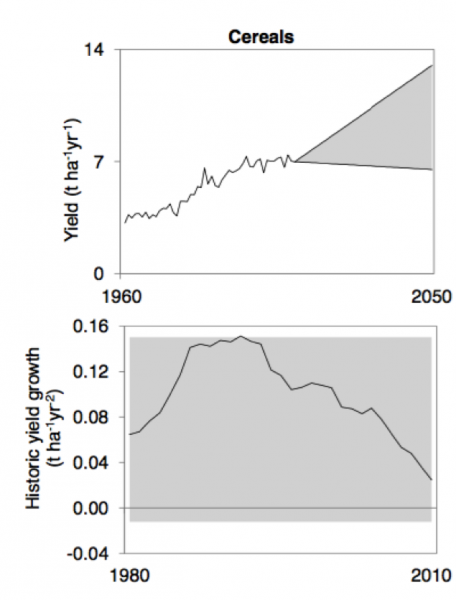
Those concerned with climate change have for years promoted the benefits of energy efficiency. It makes obvious sense: the more electricity or transportation you can get per unit of energy, the less climate damage that would result. Everyone agrees that energy efficiency is an essential part of tackling greenhouse gas emissions.
But what about agricultural efficiency? Estimates vary, but greenhouse gas emissions from world farming are estimated to be as much as a quarter of the global total. Many of these sources are difficult to reach: how do you stop cattle belching or rice paddies from emitting methane? By comparison, switching coal-fired power to clean energy sources like wind or nuclear looks easy.
Agricultural emissions are also rising rapidly and apparently inexorably, driven by world population growth and changing diets (with higher meat consumption in developing countries), in particular. Increasing agricultural efficiency in terms of crop productivity per unit of land area and animal feed conversion to meat and dairy is a critical though often overlooked aspect of the overall picture.

An excellent paper published this week in the journal Nature Climate Change sheds new light on the potential for agricultural efficiency to help tackle global warming. [Read the press release from Rothamsted Research here.] Looking at the UK farming sector, it estimates that yield improvements could offset as much as 80% of the country’s farming emissions in the most optimistic scenarios. The graph below shows the relationship between yield and greenhouse gas emissions.
Led by Anthony Lamb at Cambridge University’s Department of Zoology, the paper s authors construct a model of the extensive land sparing that takes place as productivity increases slow down the demand for farming land. Spared land then gradually becomes carbon-absorbing forestry or peat bog. In the most optimistic projection of productivity increases, 700,000 hectares of land is spared for peat bogs, while 4.4 million hectares become forest. This is great news for biodiversity as well as for climate change.
How do these yield improvements come about? As expected, there is no one-size-fits-all solution. Genetic improvements can contribute in numerous ways, but agronomic considerations such as fertiliser use and crop rotations also have an effect. Reducing food waste is also critically important. Unfortunately, the trend in European farming has been towards a plateauing of yield increases since the 1990s, as the graph below shows. Reversing this levelling out of yield growth is clearly an immediate priority.
This research will come as a challenge to those who advocate for more extensive and lower-yield farming systems such as organic agriculture, which tends to have substantially lower yields (estimates differ as to the precise magnitude). This might be more wildlife-friendly on the farm, but as more land needs to be cultivated to produce the same amount of food, overall the environmental effect may be worse. For all its obvious drawbacks, modern intensive farming has allowed vast areas of land to be spared from the plough, avoiding the emission of a colossal 160 billion tonnes of GHGs according to one 2010 estimate (PNAS).
Often in energy debates there is a perceived tension between those who advocate lifestyle change (drive less!) and those who support technological change (cleaner cars!). The truth is we need both approaches and the same applies in farming. One of the most important contributions offered by this latest research is that reducing meat consumption in UK diets is just as important as improving on-farm efficiency. So let’s hear it for vegans and vegetarians you are already doing far more than most to save the planet!
